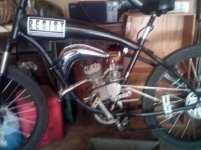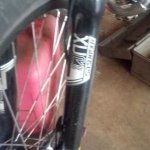Ru14real said:
New noob here, so be genital.
I hope you mean "gentle".

I am wanting to build a front wheel system, but I have a few questions here. I am look to buy this motor. Its the QS 205 35H V. I want to install it on the front forks, with a rack for the batteries above the wheel.
The more weight on the front end, especially that sits out over the wheel, the more it will affect steering, as it slows down the response time of you twisting the handlebars because of the extra inertia. The closer the weight is to the center of the pivot (line straight thru the steerer tube), the less of a problem that is. The further from that point, the worse the problem is.
With any front fork motor, I highly recommend a good torque arm on each side to secure the axle from rotating in the dropouts, which can break the dropouts and leave you laying on the ground some distance in front of the bike in a very bad mood.
There are a number of good threads for torque arms, with pictures, and ways to ensure they're mounted correctly. The full list of such threads is daunting
https://endless-sphere.com/forums/search.php?keywords=torque+arm*&terms=all&author=&sc=1&sf=titleonly&sr=topics&sk=t&sd=d&st=0&ch=300&t=0&submit=Search
though the titles of the threads in the list can eliminate a number of them just by looking thru the title list, but this one
https://endless-sphere.com/forums/viewtopic.php?f=2&t=26444
probably has the most info in a single thread with pics.
What kind of controller should I get with this motor? I really have no idea. A three speed system would be ok, I guess. 72V? What is the difference between brand names? What do you look for in a controller? I really have no idea here.
It all depends on what features you want, and how much power you need from the system. With a front motor you may be limited in how much power you can really use, depending on your riding conditions. There's some threads that discuss that part:
https://endless-sphere.com/forums/search.php?keywords=front++rear+motor&terms=all&author=&sc=1&sf=titleonly&sr=topics&sk=t&sd=d&st=0&ch=300&t=0&submit=Search
There's not a lot of difference with most controllers between brand names, as the brand is just a label somebody stuck on a controller they bought from someone else. Even most of the companies that "make" motors don't actually make them, they just put their own labels on somebody else's.
The places that sell "kits" generally just take cheap parts from various places and stick them all in a box together, and they may not even directly plug into each other without you figuring out all the wiring on your own, as the "manual" they might or might not bother to include will probably not even match the wire colors or connectors (or even amount of wires) on the various parts of the kit.
The easiest way to do it is to buy the controller, throttle, display, etc., from the same place as the motor, and make sure that what they are going to send you already has matching connectors that are already correctly wired to just plug in and go.
If you don't, or if they lie and just send whatever, then it'll be up to you to figure out all the wiring. There's at least hundreds, if not thousands, of threads around here where people try to figure that out for their stuff--often they're successful; sometimes they give up. (becuase you can't know if it's not working because the wires are wrong, or becuase something came to you defective out of the box).
If you want to just go find a separate controller, I'd recommend a place with good support to help you figure out the wiring, like http://ebikes.ca.
The stuff on ebay and the like is unlikely to have any useful support, and the "manual" they have probably doesn't even match the item you'll receive.
Since that motor is (according to a quick google of the model you give) about a 1000w brushless motor, then a 48v 20A brushless controller would run it about in it's stated power range. I'd recommend a sensored (not sensorless) controller for better startup performance, but one that can do either sensored or sensorless is nice for the possible eventual hall sensor / wiring failure eventuality (cuz it'll be able to still work without fixing the sensor).
If you want to run 72v for much higher speed, you'd want a 72v 10A controller to stay around the 1000w mark for the motor's spec.
You can use higher power with most motors, but the heat generated is greater, and the higher you go the more heat there is, and at some point it can be more than the motor can handle. There are threads about heating and cooling of hubmotors that detail how to deal with that to safely use a smaller motor at power levels it's not designed for, if you really want to do the work.
Batteries, How big should 4 or 5 brick be?
What brick? If you're talking about RC LiPo, there's many configurations so "brick" is not a useful term. You'd have to specify which brand, their supposed/advertised C-rate, their capacity, how many cells in series in each brick, etc.
Will they fit on the rack, mounted in the front? Do I really need 4 bricks, or could something smaller be better? Where would the bricks come from? Any links or recommendations?
My recommendation is not using "bricks" at all, but rather to get a complete battery pack already prebuilt, that comes with a charger specifically for it, like those from EM3EV or Grin Tech http://ebikes.ca, etc. That way you don't have any building of the battery to deal with, or packaging, it's all ready to go and mount on the bike.
If you already have experience with designing and building batteries, and maintaining them, then making your own out of smaller batteries or cells can be cheaper. But based on your questions I'm assuming you don't have any experience with that, and so I'd recommend the prebuilt ones.
Either way you go, you first need to determine your power needs, which means deciding on a controller voltage/current level first.
That means determining your riding needs, so you need to know how fast you're going to go, how quickly you need to get to that speed from zero, how much pedalling you're going to be doing, what weather / wind conditions you'll ride in, and what terrain you'll be riding on, how much you and the bike weigh, etc.
Lots of hills takes more power than cmopletely flat roads.
Same with a lot of wind vs calm still air.
Same with higher speeds vs lower ones.
Same with really quick acceleration vs getting up to speed more slowly.
Same with more stops/starts vs continuous riding.
Same with higher rider and bike weight vs lighter rider/bike.
etc.
Also I have heard that vibration is not good for the system. I guess its not good for any system, but the electronics in particular could be reduced, if possible. Would there be a difference in mounting the batteries, and controller in front or on the rear rack?
Only if there's a difference in the shock-absorbers at one end or the other, or in whetehr the frotn or rear racks are mounted on the bike frame or on the swingarm/fork legs. If the racks are unsuspended, it's really about the same at either end of the bike.
Controllers are generally better at handling the vibration than chargers are, so if you mount the charger on the bike, get one that's designed for that, like the Satiator from http://ebikes.ca or some of the Meanwell HLG series LED PSUs discussed in many threads around the forum. Those are sealed and potted against weather and vibration (but more expensive than the common chargers). Or just don't mount the charger on the bike, and just keep one at each location you need to charge at, or carry it in a backpack you wear while riding.
The controller can probably handle the vibration; there are sealed potted controllers too like the Phaserunner from http://ebikes.ca if you have an extreme condition you don't think regular ones will survive.



